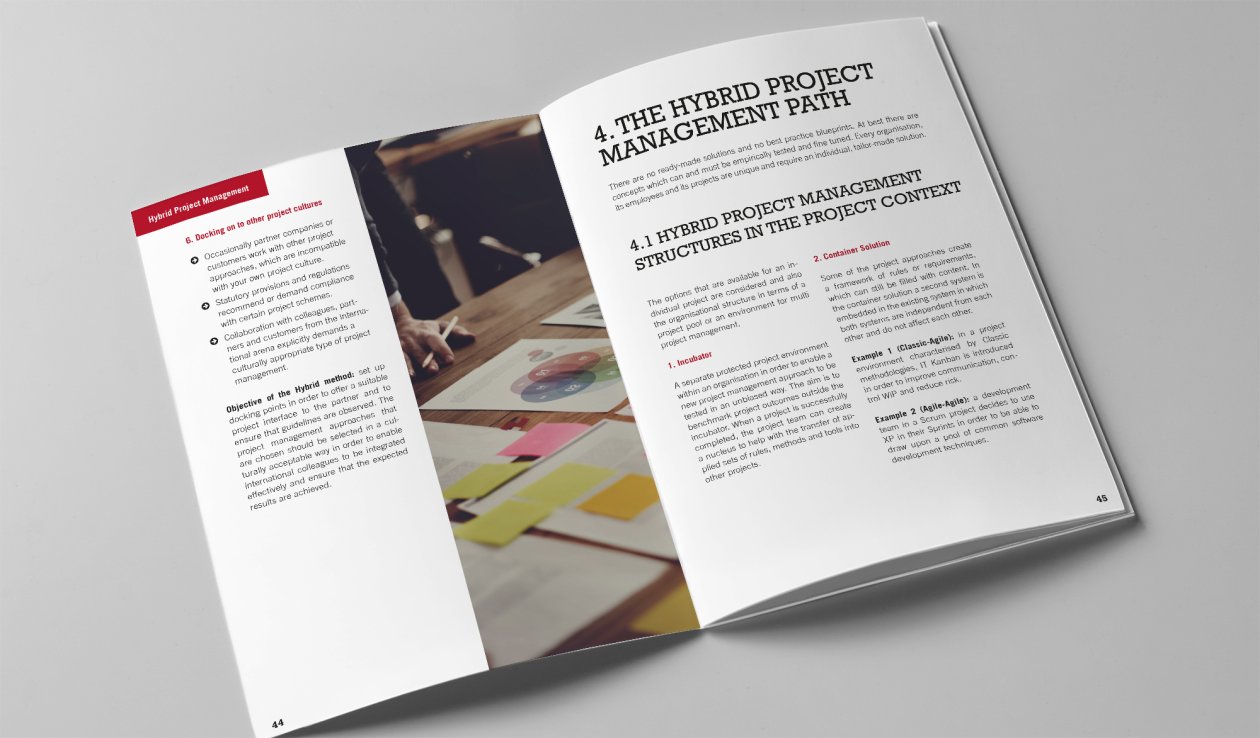The White Paper Hybrid Project Management
The IAPM's Hybrid Project Management Baseline
What is the White Paper Hybrid Project Management
Unlike other PM Guides produced by the IAPM, the White Paper Hybrid Project Management does not provide a basis for IAPM certification, but was developed independently from any certification process as a white paper to hybrid project management.
In this white paper, interested project managers will be able to find definitions, an introduction to hybrid project management and will learn information about its different components. Delving more deeply into the subject of hybrid project management would particularly suit project managers who already have experience and knowledge of traditional project management and who have also mastered and experienced the different forms of agile project management and/or Lean Management.
In this white paper, interested project managers will be able to find definitions, an introduction to hybrid project management and will learn information about its different components. Delving more deeply into the subject of hybrid project management would particularly suit project managers who already have experience and knowledge of traditional project management and who have also mastered and experienced the different forms of agile project management and/or Lean Management.

How is the White Paper Hybrid Project Management structured?
Alongside a short introduction, the White Paper is divided into three main sections.
The chapter entitled “The Three Most Important Project Management Approaches” deals with the broad fields of traditional project management, Lean Management and agile project management.
In the area of traditional project management, the possible project phases involved in a development project and the different ways of organising projects and the project roles are discussed.
You will subsequently become more familiar with the principles of Lean Management and the foundations of agile project management. You will gain a brief insight into Scrum, IT Kanban, Extreme Programming, Design Thinking and Feature Driven Development.
In the chapter entitled “The Baseline for Hybrid Project Management”, the different types of hybrid project management are described along with the deciding factors that are critical when creating a suitable hybrid system.
These factors can include both the complexities presented by the project objectives, as well as the requirements that arise from the project, the business sector or the team itself. The organisational environment and the cultural aspects of change are also part of these considerations.
It explains the reasons that can lie behind the use of hybrid project management and the sorts of things that can constitute the goal of the hybrid approach in a specific situation.
In the chapter entitled “The Hybrid Project Management Path”, the structures of hybrid project management in the project context are set out and the challenges presented by hybrid cultures are considered.
The chapter entitled “The Three Most Important Project Management Approaches” deals with the broad fields of traditional project management, Lean Management and agile project management.
In the area of traditional project management, the possible project phases involved in a development project and the different ways of organising projects and the project roles are discussed.
You will subsequently become more familiar with the principles of Lean Management and the foundations of agile project management. You will gain a brief insight into Scrum, IT Kanban, Extreme Programming, Design Thinking and Feature Driven Development.
In the chapter entitled “The Baseline for Hybrid Project Management”, the different types of hybrid project management are described along with the deciding factors that are critical when creating a suitable hybrid system.
These factors can include both the complexities presented by the project objectives, as well as the requirements that arise from the project, the business sector or the team itself. The organisational environment and the cultural aspects of change are also part of these considerations.
It explains the reasons that can lie behind the use of hybrid project management and the sorts of things that can constitute the goal of the hybrid approach in a specific situation.
In the chapter entitled “The Hybrid Project Management Path”, the structures of hybrid project management in the project context are set out and the challenges presented by hybrid cultures are considered.
How to access the White Paper Hybrid Project Management?
Click on the button below to get access to the White Paper Hybrid PM:
Our groups and channels
Do you like our offer?
That's great! Feel free to follow us on LinkedIn or Twitter.
If you don't want to miss any news, you can subscribe to our newsletter.
If you don't want to miss any news, you can subscribe to our newsletter.

